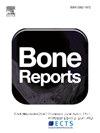Ano5Cys360Tyr mutation leads to bone dysfunction of gnathodiaphyseal dysplasia via disturbing Akt signaling
IF 2.6
Q3 ENDOCRINOLOGY & METABOLISM
引用次数: 0
Abstract
Background
Gnathodiaphyseal dysplasia (GDD) is a rare autosomal dominant genetic disease characterized by osteosclerosis of the tubular bones and cemento-osseous lesions of the mandibles. Anoctamin 5 (ANO5) is the pathogenic gene, however, the specific molecular mechanism of GDD remains unclear. Herein, a knockin (Ano5KI/KI) mouse model expressing the human mutation p.Cys360Tyr was used to investigate the role of Akt signaling in enhanced osteogenesis and decreased osteoclastogenesis in GDD.
Methods
Bone marrow-derived macrophages (BMMs) and mouse calvarial osteoblasts (mCOBs) were isolated from homozygous Ano5KI/KI mice and treated with SC79, a specific Akt activator. The differentiation and F-actin ring formation of osteoclasts were examined by TRAP and phalloidin staining, respectively. Osteoblast differentiation and mineralization were examined by ALP and alizarin red staining. The expression of bone remodeling-related factors was measured by qRT-PCR.
Results
Akt activation promoted the generation of TRAP-positive multinucleated osteoclasts and the formation of actin rings in Ano5KI/KI BMMs cultures, accompanied by increased expression of Nfatc1, Trap, Dc-stamp, Mmp9, Ctsk, and Atp6v0d2. Additionally, Ano5Cys360Tyr mutation down-regulated the Akt phosphorylation level in osteoblast. ALP activity and matrix mineralization capacity in Ano5KI/KI osteoblast cultures were inhibited after SC79 stimulation, with reduced expression of Runx2, Opn, Col1a1, and Ocn.
Conclusion
Akt activation by SC79 stimulation can obviously rescue abnormal increased osteogenesis and decreased osteoclastogenesis in Ano5KI/KI mouse model, which demonstrated that disturbed Akt signaling pathway may play a pivotal role in the pathogenesis of GDD, and an Akt activator is probable a therapeutic target for GDD.
Ano5Cys360Tyr突变通过干扰Akt信号导致颌骨干发育不良的骨功能障碍。
背景:颌骨干发育不良(GDD)是一种罕见的常染色体显性遗传病,其特征是下颌骨管状骨硬化和骨水泥病变。ANO5是致病基因,但GDD的具体分子机制尚不清楚。本研究采用表达人类突变p.Cys360Tyr的敲入蛋白(Ano5 KI/KI)小鼠模型,研究Akt信号在GDD中促进成骨和降低破骨细胞生成中的作用。方法:从纯合子Ano5 KI/KI小鼠中分离骨髓源性巨噬细胞(BMMs)和小鼠颅骨成骨细胞(mCOBs),并用特异性Akt激活剂SC79处理。分别用TRAP和phalloidin染色检测破骨细胞的分化和F-actin环的形成。ALP和茜素红染色检测成骨细胞分化和矿化。采用qRT-PCR检测骨重塑相关因子的表达。结果:Akt激活促进Ano5 KI/KI BMMs培养中Trap阳性多核破骨细胞的产生和肌动蛋白环的形成,同时Nfatc1、Trap、Dc-stamp、Mmp9、Ctsk和Atp6v0d2的表达增加。此外,Ano5 Cys360Tyr突变下调了成骨细胞中Akt磷酸化水平。SC79刺激后,Ano5 KI/KI成骨细胞ALP活性和基质矿化能力受到抑制,Runx2、Opn、Col1a1和Ocn的表达降低。结论:在Ano5 KI/KI小鼠模型中,SC79刺激激活Akt可明显恢复异常的成骨增加和破骨细胞减少,这表明Akt信号通路紊乱可能在GDD发病中起关键作用,Akt激活剂可能是GDD的治疗靶点。
本文章由计算机程序翻译,如有差异,请以英文原文为准。
求助全文
约1分钟内获得全文
求助全文
来源期刊

Bone Reports
Medicine-Orthopedics and Sports Medicine
CiteScore
4.30
自引率
4.00%
发文量
444
审稿时长
57 days
期刊介绍:
Bone Reports is an interdisciplinary forum for the rapid publication of Original Research Articles and Case Reports across basic, translational and clinical aspects of bone and mineral metabolism. The journal publishes papers that are scientifically sound, with the peer review process focused principally on verifying sound methodologies, and correct data analysis and interpretation. We welcome studies either replicating or failing to replicate a previous study, and null findings. We fulfil a critical and current need to enhance research by publishing reproducibility studies and null findings.
文献相关原料
公司名称
产品信息
索莱宝
DAPI solution
索莱宝
Methyl green staining solution
 求助内容:
求助内容: 应助结果提醒方式:
应助结果提醒方式:


